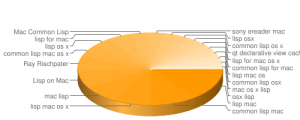I’ve been dabbling in Haskell since at least 2005, but I’ve never gained fluency. The reason is simple: I’ve never programmed anything of reasonable size in it. I use it a lot for little functional calculation programs, things like utilities for computing the great-circle distance between two points, stuff like that, but haven’t taken the plunge and done anything big enough to really push my understanding forward.
At the Day Job(tm) at Nokia, most of my work is still Qt, with an increasing amount of web technologies (WebGL/HTML 5/CSS/JavaScript) thrown in to visualize results from the research work being done. I feel like I’m stagnating though — I’m comfortable enough with all of those things that I can easily get the job done, and I’m not really learning anything new. Worse, most of the time I feel like I’m writing the same code over and over, parameterized in only a couple of dimensions.
I could lobby for Haskell at the office, but unfortunately that would probably go over like a French kisser at a family reunion — the team has settled on Matlab for prototyping, C++ for performance computation using OpenCV for its vision libraries, Python for data wrangling, and Mongo for databases, with WebGL/HTML 5/CSS/JavaScript and Python in front of the database for data visualization when our older Qt/C++ visualization stuff looks ragged around the edges. I played a part in this decision-making process, and stand by the advice I gave — we’re a cross-disciplinary team with clear objectives in both research and product development, and unfortunately there’s just not room for the hit that coming up to speed and moving all of our existing code to Haskell would take. Moreover, the teams where our code goes after we’re done with it would balk as well — they’re doing some really big compute stuff in Hadoop, and made their bed and will lie in it.
But that leaves me at loose ends; I spent some time working on a book project this winter that’s sort of stalled out (my fault, need to find a publisher and finish it), and looking to sink my teeth into Haskell again. And I think I’ve found the project. There’s a collection of documents from Quakers I want to collect and put in a database, first and foremost for me, but others may benefit as well. Slapping a web front end on the database makes for an easy UI to the database, and would scale well once I collect the data if I decide to share it with other people.
Enter Yesod, a Web framework written in Haskell. It looks to be stable and highly performant, and well-documented, too — some good Web tutorials, and even a book (which of course I’ve already ordered.)
So I’ve decided that rather than using a framework like I know a little about and knock together something in an evening, I’ll stretch a bit and do it in Yesod instead. Building a front end to the database for the data I want to collect in Yesod should get me past the baby steps of writing a few type classes and a bunch of simple functions, with the occasional higher-ordered function thrown in. And, once I get some data in the database, if I decide to open up the data to other users, it’ll need a more robust front end, which requires more bits of Haskell, I’m sure.
In the process, I’ll capture what I do on the project here. It doesn’t pertain to the last book I wrote, or the book before that, but hopefully it’ll be of use to others, and writing for an audience (no matter how small) always forces me to understand what I’m doing better than if I do it alone.
Expect a post or two a week, some weeks more, some weeks less, as time permits. I have some good chunks of time in the next couple weeks to get started, then I go on vacation for a bit — during which either I’ll post a lot less or a lot more, depending on how I feel about things.
